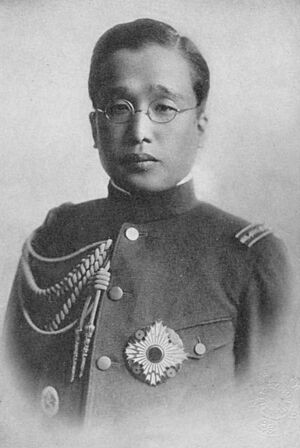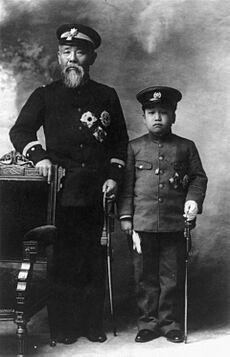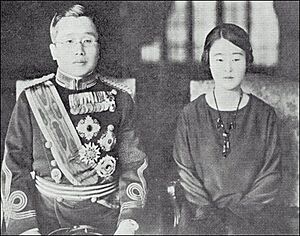Yi Un facts for kids
Quick facts for kids Yi Un |
|||||||||
|---|---|---|---|---|---|---|---|---|---|
| Crown Prince of Korea | |||||||||

Yi Un as a lieutenant of the IJA, 1920s
|
|||||||||
| Head of the House of Yi | |||||||||
| Period | 24 April 1926 – 1 May 1970 | ||||||||
| Predecessor | Emperor Sunjong | ||||||||
| Successor | Crown Prince Yi Ku | ||||||||
| Born | 20 October 1897 Deoksu Palace, Seoul, Empire of Korea |
||||||||
| Died | 1 May 1970 (aged 72) Nakseon Hall, Changdeok Palace, Seoul, South Korea |
||||||||
| Burial | Yeongwon Hongneung, Namyangju, Gyeonggi Province, South Korea | ||||||||
| Spouse |
Princess Masako of Nashimoto of Japan
(m. 1920–1970) |
||||||||
| Issue | Prince Yi Jin Crown Prince Yi Ku of Korea |
||||||||
|
|||||||||
| House | Yi | ||||||||
| Father | Emperor Gojong of Korea | ||||||||
| Mother | Imperial Noble Consort Sunheon | ||||||||
| Military career | |||||||||
| Allegiance | |||||||||
| Service/ |
|||||||||
| Years of service | 1917–1945 | ||||||||
| Rank | |||||||||
| Unit | North China Area Army Chosen Army Inspectorate General of Military Training Supreme War Council |
||||||||
| Commands held | Imperial Guards 2nd Brigade 51st Division First Air Army |
||||||||
| Battles/wars | Second Sino-Japanese War Second World War |
||||||||
| Awards | Grand Cordon of the Supreme Order of the Chrysanthemum | ||||||||
Yi Un (Korean: 이은; 20 October 1897 – 1 May 1970) was the last Imperial Crown Prince of the Korean Empire. He was also the 28th Head of the Korean Imperial Family. Later, he became a general in the Imperial Japanese Army.
Before 1907, Yi Un was known as Prince Imperial Yeong. In 1910, Japan took control of the Korean Empire. Emperor Sunjong of Korea had to give up his power. Yi Un then married Princess Masako of Nashimoto from Japan in 1920.
After Emperor Sunjong passed away in 1926, Yi Un received the title King Yi of Changdeokgung. He rose to the rank of Lieutenant General in the Japanese Army. He led Japanese forces in China and was part of the Supreme War Council. After World War II, he was not allowed to return to Korea at first. His Japanese titles were also removed in 1947. After his death in 1970, he was given the special name Crown Prince Uimin.
Contents
Early Life of Prince Yi Un

Yi Un was born on October 20, 1897, in Seoul, at Deoksu Palace. He was the seventh son of Emperor Gojong. His mother was a palace attendant named Eom Seon-yeong. She was later given the title Princess Sunheon.
Yi Un was the younger half-brother of Emperor Sunjong. In 1900, he was named Prince Imperial Yeong. He became the crown prince in 1907. This happened even though he was younger than his half-brother, Prince Ui. Prince Ui's mother had passed away, so he had less support at court.
Yi Un's Time in Japan
In December 1907, Yi Un was sent to Japan. This was arranged by Itō Hirobumi, a Japanese statesman. The goal was for Yi Un to attend Gakushūin Peers' School. This move was to prevent the Korean royal family from taking actions against Japan.
Japanese Emperor Meiji paid special attention to Yi Un. He acted as Yi Un's guardian. Itō Hirobumi often brought Yi Un to visit Japanese princes. These included Hirohito, Chichibu, and Takamatsu. After Itō's death, Emperor Meiji saw Yi Un less often. Yi Un could only visit Korea again after his mother died in 1911.
Military Career of Prince Yi Un
In September 1911, Yi Un joined the Army Central Youth School in Tokyo. This was a school to prepare for military service. He was not very good at gymnastics because he was small. However, he was excellent in music and martial arts.
He then joined the Imperial Japanese Army Academy. He graduated in May 1917 with a great record.
Rising Through the Ranks
Yi Un became a second lieutenant in the infantry in December 1917. He steadily moved up in rank. He became a lieutenant in April 1920 and a captain in July 1923. In November 1923, he graduated from the Army Staff College. He then led a battalion of the Guards 2nd Infantry Regiment.
In December 1924, he was assigned to the Imperial Japanese Army General Staff Office. In July 1926, he joined the staff of the Chosen Army. He visited Korea with his wife in 1926 to see Emperor Sunjong.
Travels and Further Promotions
In May 1927, Yi Un went on a long trip to Europe. He visited many countries, including France, the United Kingdom, and Germany. He returned to Japan in April 1928. In August, he was promoted to major. In August 1929, he became the commander of the IJA 1st Infantry Regiment.
In December 1930, he was assigned to the Inspectorate General of Military Training. He became a lieutenant colonel in August 1932. In August 1935, he was promoted to colonel. He commanded the IJA 59th Infantry Regiment. From April 1937, he taught at the Army Academy.

World War II Service
In July 1938, Yi Un became a major general. From December, he worked with the North China Area Army. This army was fighting in northern China during the Second Sino-Japanese War. In 1939, he inspected many front-line units. He also reviewed troops in Manchukuo.
In August, he was made commander of the Guards 2nd Brigade. In May 1940, he commanded the reserve Fourth Depot Division. He was promoted to lieutenant general in December. In July 1941, he became commander of the IJA 51st Division.
His division moved to Manchukuo for a special exercise. This was a preparation for a possible conflict with the Soviet Union. These war preparations were stopped in August 1941. In September, his division moved to Guangdong. In November, he returned to the staff of the Inspectorate General of Military Training.
From August 1942, Yi Un moved to the Imperial Japanese Army Air Force. He became commander of the 1st Air Army in July 1943. In April 1945, he became a member of the Supreme War Council.
Later Life and Return to Korea
After Japan surrendered in World War II, Yi Un lost his royal status in 1947. He was also declared stateless. Korea had become independent from Japan. However, Syngman Rhee, the Korean President, did not allow him to return to Korea.
In May 1947, he gained Japanese citizenship. He traveled to the United States that same month. In March 1959, he suffered a stroke while in the United States. He returned to Japan in May. In 1960, President Rhee again refused his return to Korea. Instead, Rhee offered him a job as Korean Ambassador to the Court of St. James's. Yi Un refused due to his illness. He did travel to New York and Hawaii for short periods. His health got worse, and he was hospitalized in Tokyo in August 1961.
In November 1963, President Park Chung Hee finally allowed Prince Yi Un and Crown Princess Bangja to return to Korea. By then, Prince Yi Un was unconscious from a cerebral thrombosis. He received treatment at St. Mary's Hospital in Seoul.
In his last years, Prince Yi Un lived at Nakseon Hall in Changdeok Palace in Seoul. This was the former home of the Korean Imperial Family. He lived there with his wife, Bangja, and his younger sister, Princess Deokhye. He passed away on May 1, 1970, at Nakseon Hall. He was buried at Hongreung in Namyangju, near Seoul.
Children of Yi Un
- Yi Jin (born August 18, 1921 – died May 11, 1922) was the older son of Prince Yi Un and Princess Bangja. Yi Jin passed away suddenly as a baby while visiting Korea with his parents. His funeral was held on May 17, 1922, and he is buried in Korea.
- Yi Gu (born December 29, 1931 – died July 16, 2005) was the second son of Prince Yi Un and Princess Bangja. Prince Gu became the 29th Head of the Korean Imperial Household after his father's death. He married an American citizen, Julia Mullock, in 1959. They did not have children of their own but adopted a daughter, Eugenia Unsuk Lee.
Honors and Recognition
Yi Un received many honors throughout his life from different countries.
 Korean Empire: Grand Cordon of the Order of the Golden Ruler – 1900
Korean Empire: Grand Cordon of the Order of the Golden Ruler – 1900 Empire of Japan: Grand Cordon of the Order of the Rising Sun, with Paulownia Flowers – 1907
Empire of Japan: Grand Cordon of the Order of the Rising Sun, with Paulownia Flowers – 1907 Denmark: Grand Cross of the Order of the Dannebrog – 1927
Denmark: Grand Cross of the Order of the Dannebrog – 1927 Sweden: Commander Grand Cross of the Order of Vasa, with Collar – 1927
Sweden: Commander Grand Cross of the Order of Vasa, with Collar – 1927 Czechoslovakia: Grand Cross of the Order of the White Lion – 1927
Czechoslovakia: Grand Cross of the Order of the White Lion – 1927
Legacy of Crown Prince Uimin
Yi Un is known after his death as Yi Un, Crown Prince Euimin of Korea. In 1973, President Park Chung Hee approved placing Yi Un's spirit tablet in the Jongmyo shrine. This followed old royal traditions.
Yi Un's former home in Tokyo, called Kitashirakawa Palace, was built in 1930. After World War II, it became the Akasaka Prince Hotel. This hotel opened in 1955. After the hotel was taken down in 2013, the building was renovated. It is now a banquet hall known as Akasaka Prince Classic House. It is part of Tokyo Garden Terrace Kioicho.
Images for kids






